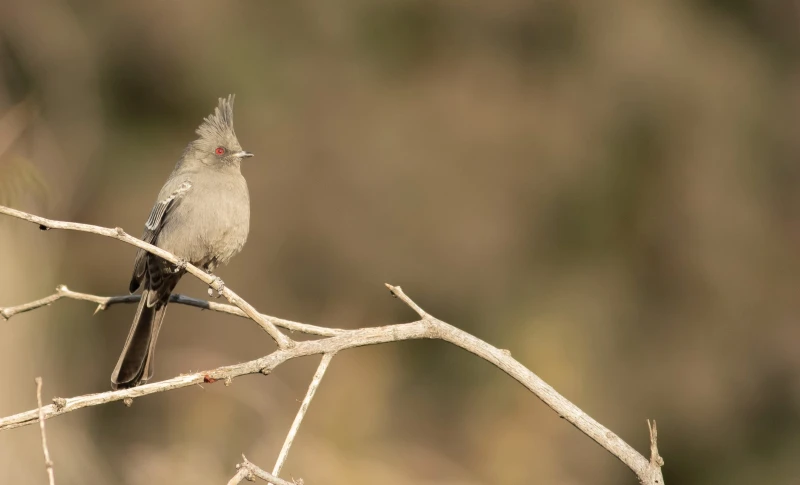‘Tis the season for mistletoe wreaths and ornaments, but we don’t need decorations to find plenty of mistletoe in the Mojave Desert. And no bird here loves mistletoe as much as the Phainopepla. They spend the winter feasting on desert mistletoe berries as red as their eyes, whistling from thorny patches of trees where they stake out their territory. Both the jet-black males and brown-gray females have spiky head crests that stick up like barbs against the sky. You can find these sleek birds in places like Sunset Park, Clark County Wetlands Park, Springs Preserve, Corn Creek, and other places where desert mistletoe is abundant.
When searching for desert mistletoe, look for matted red clusters hanging off the branches of spiny trees like honey mesquites and catclaw acacias. Desert mistletoe hangs this way because it parasitizes host trees for water and nutrients by penetrating their bark with its root-like tendrils. The mistletoe’s sticky red berries are an enticing food source for Phainopeplas and other birds like Northern Mockingbirds and American Robins. When birds eat the berries, they poop out more desert mistletoe seeds, helping this plant spread to different trees.
Because Phainopeplas and desert mistletoe are so intertwined, they teach us a lot about the health of the Mojave Desert. Phainopeplas depend on the health of desert mistletoe. And as a parasitic plant, desert mistletoe depends on the health of its host plants. This is becoming more challenging in our megadrought, as groundwater pumping and hotter annual temperatures are affecting springs and underground aquifers that some desert plants have historically relied on. Already pushed to the desert extreme, it is uncertain how plants like catclaw acacias, creosote, and screwbean and honey mesquites will fare with even less water. But when desert mistletoe parasitizes already-weakened trees, the trees are more likely to die and the mistletoe along with them.
Where there is less desert mistletoe, there are fewer Phainopeplas. According to Nevada Partners in Flight, Phainopepla populations have decreased 8% between 1970 and 2016. This is part of a larger trend of desert bird decline because of climate change. And because Phainopeplas get most of their water from the mistletoe berries they eat, they are particularly sensitive to the drought and changes in desert mistletoe abundance.
Desert mistletoe is already an ephemeral food source for Phainopeplas, meaning it’s not reliably available throughout the year even though it fruits heavily in the winter. As a result, Phainopeplas have adapted to have two breeding seasons during the year, an uncommon phenomenon in the bird world known as itinerant breeding.
To help study this breeding behavior, ornithologist and RRAS member Jennifer Wilcox GPS tagged and collected genetic data from a Phainopepla population in Southern California in 2016 and 2017. She describes, “Phainopeplas are suspected to breed in desert habitats in the spring and migrate to woodland habitats to breed in the summer.”
One clue to this behavior is the Phainopepla’s vocal mimicry skills, as desert individuals will mimic woodland birds and vice versa. The five individuals that were tagged migrated to coastal woodland habitats in Southern California in the summer, which suggests that Phainopeplas may be opportunistic breeders who shift their location based on food availability. You can see how Phainopeplas move around using National Audubon’s Bird Migration Explorer.
Phainopeplas have shown flexible behavior beyond their itinerant breeding. In places like Sunset Park, they can be found year-round in the honey mesquite groves. They’ll also eat nonnative berries from plants like pyracantha, boxelder, grapevine, and elderberry. But like the honey mesquite and other plants that desert mistletoe relies on, these birds are already pushed to their climate extremes and their populations are closely monitored by biologists.
So how can birders help Phainopeplas? The best way, according to Wilcox, is to “Get out and help count and observe birds. Enter your observations into eBird and be sure to add any comments regarding behavior, what they are eating, and what habitat they are using.”
You can help keep track of Phainopepla numbers by recording them and other birds in the December Christmas Bird Counts with Red Rock Audubon Society. CBCs are the longest- running community science bird project with National Audubon, and observations help scientists track bird populations around the country. You may see Phainopeplas at any of the CBC locations.
“My favorite thing about phainopeplas is how much personality and attitude they can pack into such a little body,” Wilcox says. “They rock a funky feather-do and have the coolest song. And if you get in between them and their mistletoe they will be sure to let you know about it. Once when I was camping in Lake Mead NRA I was brushing my teeth next to an acacia heavily parasitized by desert mistletoe. A male phainopepla got very close to me and was calling incessantly. I watched him for a while, amused, as he flitted back and forth between some other acacias on the hillside and finally figured out what he wanted - the mistletoe behind me! I moved out of the way and sure enough he flew right over to the gleaming bunch of berries and started gorging himself.”
What Phainopepla stories do you have to share?
By Morrigan DeVito
Photo Credit: Alex Harper










